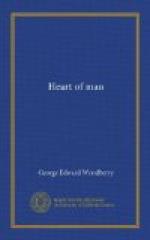“Equal, unclassed, tribeless, and nationless”;
in the unity of the truth of his spirit they are freed from mortality, they are mutually intelligible and interchangeable, they survive,— racial and secular states and documents of a spiritual evolution yet going on in all its stages in the human mass, still barbarous, still pagan, still Christian, but an evolution which at its highest point wastes nothing of the past, holds all its truth, its beauty, its vital energy, in a forward reach.
The nature of the changes which time brings may best be illustrated from the epic, and thus the opposition of the transient and permanent elements in art be, perhaps, more clearly shown. Epic action has been defined as the working out of the Divine will in society; hence it requires a crisis of humanity as its subject, it involves the conflict of a higher with a lower civilization, and it is conducted by means of a double plot, one in heaven, the other on earth. These are the characteristic epic traits. In dealing with ideas of such importance, the poets in successive eras of civilization naturally found much adaptation to new conditions necessary, and met with ever fresh difficulties; the result is a many-sided epic development. The idea of the Divine will, the theory of its operation, and the conception of society itself were all subject to change. Epics at first are historical; but, sharing with the tendency of all art toward inwardness of meaning, they become purely spiritual. The one thing that remains common to all is the notion of a struggle between a higher and a lower, overruled by Providence. They have two subjects of interest, one the cause, the other the hero through whom the cause works; and between these two interests the epic hovers, seldom if ever identifying them and yet preserving their dual reality.




